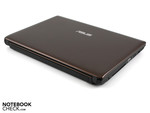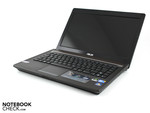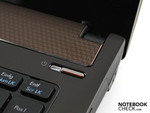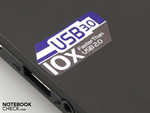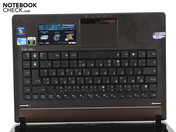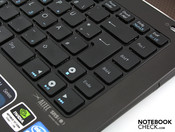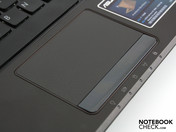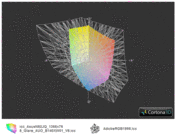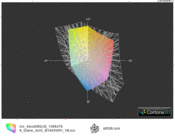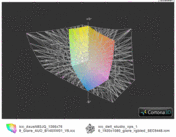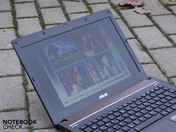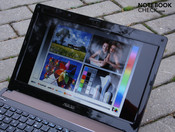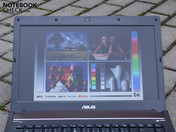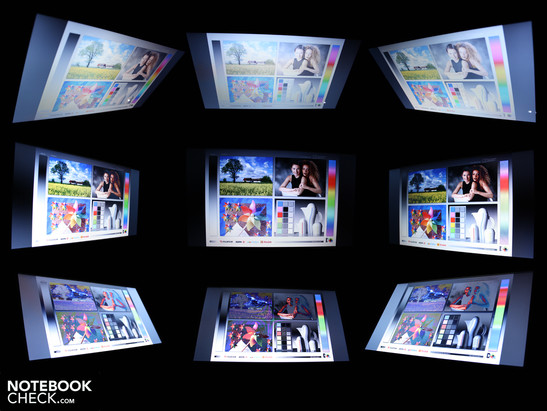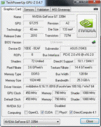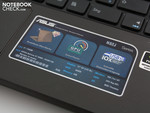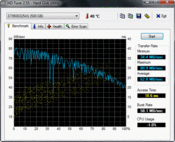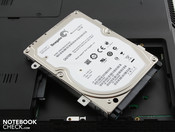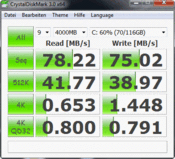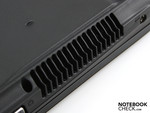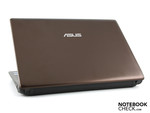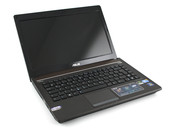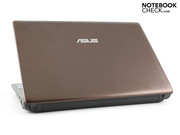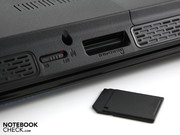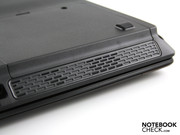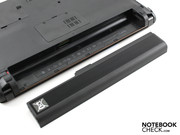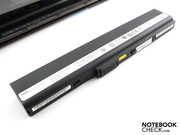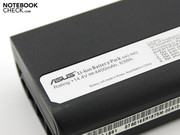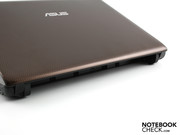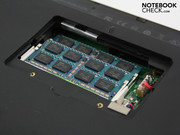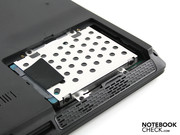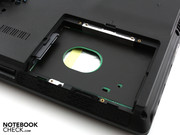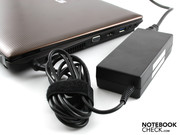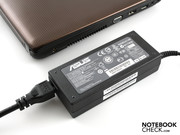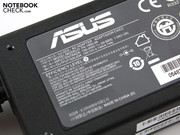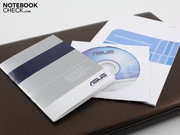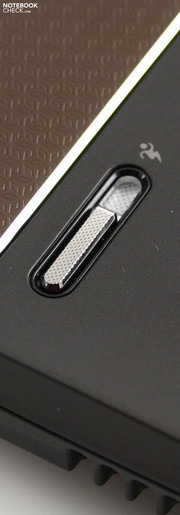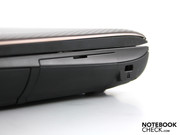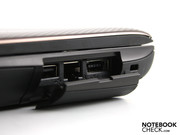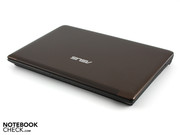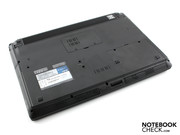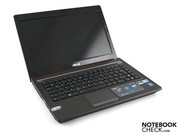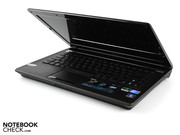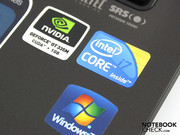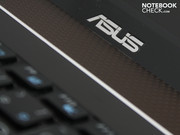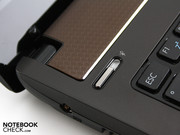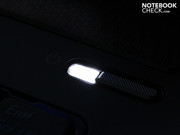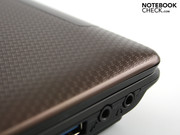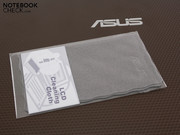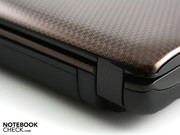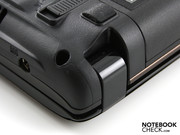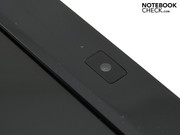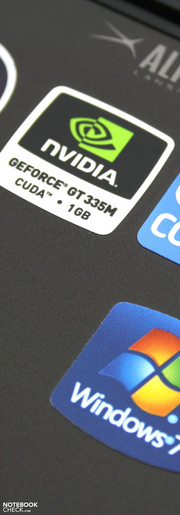Review Asus N82JQ Notebook

Notebook buyers approach choosing a device with the most various needs. A simple office model without many bells and whistles suffices home users who want to surf on the internet. They will likely only look at the mobility factors, like matt display, battery life and workmanship, in reviews.
Performance orientated buyers consider additional factors. Strong graphics for gaming, just like a quad core processor from Intel's 2010 CPU generation is a must have. But if the device costs as much as 900 euro, then it has to be a good looker, too.
The 14 inch Asus N82JQ-VX046V seems to be exactly such a notebook. Core i7-720QM and GeForce GT 335M keep the power upright and structured aluminum surfaces provide the optical accents. An elegant but nevertheless strong machine for 900 euro? Find out everything about the benefits, but also about the drawbacks of the Asus N82JQ.
Case
The 14 incher doesn't have a slim silhouette and the N82JQ can't hold a candle to a slim Acer TimelineX. It doesn't have to, either. In view of its high performance, potential buyers will gladly accept its 2414 grams and the fairly high base unit.
Users will have delight in the high-end surfaces of lid and case, though. The matt, respectively slightly glossy surfaces make a desktop suitable, and at the same time elegant, impression. The N82JQ is thus suitable for mannerly customer contact on the one hand and for a bit of showing off among friends on the other
We can only twist the chassis the slightest bit when considerable force is applied by both hands. Wrist-rest and touchpad prove to be solid. The wrist-rest and the key area have a rubber finish (special coating). Thus, your hands can rest fairly secure and fingerprints are almost non-existent. Our hands feel comfortable on the dull and very wide surface.
The base unit's plate presents a matt, grippy plastic. The surfaces are solid. Merely pressure on the drive can provoke denting. There are two maintenance covers. The front one is for the 2.5 inch hard disk, the one in the center for both RAM modules.
The hinges have a secure grip on the lid and don't tend to teeter. The maximum opening angle of circa 130 degrees is just sufficient for a use on the lap. We only need one hand for opening. The heavy base unit keeps itself on the table.
Connectivity
Asus isn't stingy with interfaces and bids a good array of current connections. We find a HDMI out beside the USB 3.0 and VGA on the left. The user can connect a TV set to HDMI for transmitting video and sound. An ExpressCard34 slot is not onboard. Expansions, such as audio cards, memory media or controllers, are thus not possible.
The interfaces are well distributed on both sides. The rarely used eSATA and Ethernet ports (as well as 1 USB 2.0 port) are hidden behind a flap on the right. This provides a cleaned up look when they aren't used.
The position of HDMI and VGA in the front, lateral area adds unwieldy cables on the desk. Under certain circumstances, a leftie mouse might not be usable. If we imagine the N82JQ equipped with a cable tree, we'll see the problem on the left. eSATA, Ethernet and USB cables can be space-savingly led towards the rear on the right. Socket on the rear would have been more practical. However, the lid's mounting prevents ports on the rear.
The cardreader on the N82JQ's front is the only connection there. The 14 incher only has one hot key and it controls the energy modes (high performance, etc.).
Communication
Beside WLAN draft-n (Atheros AR9285), Bluetooth 2.1+EDR are also inside the N82JQ as wireless technologies. The Atheros AR8131 PCI-E Gigabit Ethernet card can transfer data in home networks in the fastest possible speed. The user naturally also needs a draft-n router, respectively a gigabit switch.
Supplies
There are no recovery data carriers for Windows 7 Home Premium (64 bit) included, merely a driver DVD. Thus, N82JQ buyers are prompted to create an according data carrier with the AI Recovery Burner. The LifeFrame software for taking pictures or videos with the webcam is recommendable. As we tried it out, we found out that the camera can take pictures in a high resolution of 1600x1200 pixels. Unfortunately, the webcam is very slow in this resolution and can only take focused still life pictures. The recording frame rate is by an estimated 2-3 picture per second. The rate doesn't get much better in 640x480 with an estimated 5 pictures per second.
The Asus Web Storage (500 GB online storage) typically belongs in the Asus laptop's package. Users can secure their most important files or export data regularly here.
Warranty
Asus grants a 24 month warranty with pickup service (Pickup & Return). The warranty extension by a year, from 2 years to 3 years, is available for 80 euro in online shops. The warranty extension has to be activated within 90 days of date of purchase. The package also extends the international warranty for the same period.
Input Devices
Keyboard
Asus uses a so-called isolation keyboard. The separate key are in a high gloss plastic grid, which however can be easily cleaned. Pressed key are on the same height as the glossy surface.
The key's gaps aren't as big as in desktop keyboards. However, because no number pad is used, the layout is sufficient. It could have been much larger though, if the manufacturer had used the entire width and had made the "enter" and "shift" key bigger.
The keyboard's biggest drawback isn't the layout, but rather the unsatisfactory typing feel. The keys provide the typist with a slightly spongy pressure point and a coiling stroke. The latter is caused by the yielding key surface. The sufficient key stroke length can't do anything to make things right anymore, either.
Touchpad
The same texture that adorns the lid's aluminum look is found on the touchpad. The gliding feel on it is fairly dull but not very pleasant. The large pad is sensitive up to its edges and you can navigate on it precisely and fast, despite its poor haptics.
It's a multi-touchpad (Elan Smart-Pad V2.2; driver ELAN 7.0.5.10). However, only scrolling with two fingers is recognized as a gesture (two fingers beside each other). Two finger zooming wasn't possible on the test device. There is no conventional horizontal or vertical scroll bar (one finger use) and you can't activate it, either. The keys only have a sufficient stroke length at the outer areas and have a bright click noise. Thus, the click feedback isn't perfect, but at most average.
Display
The reflective LED screen (AUO B140XW01 V8) has a resolution of 1366x768 pixels (16:9). The coarse WXGA resolution is standard in 14 inchers. The determined black value is 1.32 cd/m2 (contrast 180:1). The widescreen display thus doesn't present black as deep black, as it should be the case for a perfect TFT. A gray cast remains visible and isn't improved by the display's color friendly glare type finish.
Low contrasts are typical for office notebooks, all-rounders and netbooks. For a gaming suitable device of this price category, a higher quality screen would have been appropriate. The display isn't acceptable for professionals in the picture and video editing field. The color spectrum is far from the often used Adobe RGB 1998 (t). The same applies for RGB (t). Consequently, an average screen is used in view of color representation.
However, the LED display has two positive qualities. It distributes the brightness very evenly over the screen (98%). The maximum rate of 241 cd/m2 and the minimum rate of 236 cd/m2 are extremely close. Such a homogeneous illumination is very rare in notebooks. The average brightness of 238 cd/m2 is also above average of our test notebooks. The user rarely needs a luminance beyond 180 cd/m2 indoors. So, many will reduce the brightness because the display is otherwise too bright.
| |||||||||||||||||||||||||
Brightness Distribution: 98 %
Center on Battery: 238 cd/m²
Contrast: 180:1 (Black: 1.32 cd/m²)
42.07% AdobeRGB 1998 (Argyll 3D)
59.8% sRGB (Argyll 3D)
40.46% Display P3 (Argyll 3D)
The 14 incher's screen is rather unsuitable for outdoor use despite the good brightness. Its glare quality causes reflections and impairs the view depending on the light incidence. The users are then forced to adjust the viewing angles. We only had a very cloudy, rainy day for taking our sample pictures. The view isn't impaired due to weak sunlight here.
The N82JQ's viewing angles prove to be very narrow. When the sight deviates upwards or downwards (vertical), ghosting turns up at 20 degrees. We can deviate up to 45 degrees from the center towards the left and right (horizontal). The colors first invert evidently then.
Several people gathered in front of the N82JQ will have problems finding a good view on the display content at the same time. This critique point haunts the majority of office and multimedia notebooks. Good displays are scarce commodities.
Performance
Asus equips the N82JQ with a Core i7-720QM (4 x 1.6 GHz). It has a 256 KB Level 1 cache and a 6 MB Level 3 cache per core. The TDP is a high 45 watts. The Arrandale 32nm CPU can calculate on four physical cores with 1.60 GHz each. This low nominal rate can clock between 1.60 and 2.80 GHz in operation (Intel Turbo Boost).
Whilst applications always have the exact amount of performance that they need with Turbo Boost, not all eight threads (4 + Hyperthreading) can compute with 2.80 GHz, but rather with 8 x 1.2 GHz. When only two cores are used, the clock rate of these is 2 x 2.5 GHz, for example. Only when one core takes over the entire calculation effort can its clock rate climb to the mentioned 2.80 GHz. This is a rarely achieved case in practical use, though.
The Core i7-720QM is supported by a whole 4096 MB of RAM (PC3-10600). They are placed on two Hynix RAM modules. Unlike Core i3 and i5 processors, the i7-720QM's bundle doesn't incorporate Intel HD graphics. For this reason, Nvidia's Optimus can't be used. An Nvidia GeForce GT 335M works as the only graphics core on the Intel HM55 chip set. You'll find more about their performance in the section "Gaming Performance".
The 720QM should be able to cope perfectly with single core and multi core applications, viz. process calculations quickly, due to the maximum turbo rate of 2.8 GHz. The processing speed can be compared synthetically with the Cinebench R11.5 CPU benchmark. The CPU score is 2.82 points here, which represents the typical rate of a 720QM system. Thus, the N82JQ stands out from an i5-460M (2.3 points) or an i5-520M (2.2 points) evidently
Turbo Boost has to prove itself in Cinebench R10 Single. Here, only one thread (of eight) is demanded to full. We end up with 3622 points (average 720QM systems). The previously inferior i5-520M systems range between 3500 and 3800 points and are thus tendentiously a bit faster. The reason: The 520M has a turbo rate of 2933 GHz. Although the i5-460M used in budget consumer laptops has an identical 2.8 GHz turbo rate, the score of 3850 points (average taken from three test devices), is superior by 6%.
| PCMark 05 Standard | 6858 points | |
| PCMark Vantage Result | 5266 points | |
Help | ||
So, multi core calculations are an outstanding strength of the 720QM. Will this lead to a very good system performance, which we determine with PCMark Vantage? In this test, the CPU, graphics, RAM and hard disk collaborate, whereby CPU and hard disk have the most impact.
PCMark Vantage finishes with 5266 points. This result indicates a strong system. However, the rating is lower than in other systems with an i7-720QM. Thus, the Asus G73JH (ATI Mobility Radeon HD 5870) achieves 6199 points. The reason for this was the fast rotating 7200 rpm hard disk and the strong graphics.
The i7-720QM provides a very good performance. Nevertheless, our data base shows that even a 13.3 incher, like the Acer Aspire 3820TG, can be stronger. The little subnotebook can accomplish 6001 PCMark Vantage points with its i5-460M, an HD 5650 and a 5400 rpm HDD (75 MB/s sequential read). It's the speedy hard disk that supplies the decisive boost.
| 3DMark 03 Standard | 19526 points | |
| 3DMark 05 Standard | 13782 points | |
| 3DMark 06 Standard Score | 6938 points | |
| 3DMark Vantage P Result | 3234 points | |
Help | ||
The 500 GB hard disk from Seagate (ST9500325AS) has a share in the average PCMark Vantage rating (in relation to 720QM systems). The HDD score is 3251 points (average for 5200 rpm disks). The data throughput in read, determined with HD Tune, is 62.8 MB/s. First fast rotating 7200 rpm HDDs achieve higher throughputs (about 75 MB/s), which can result in, for example, a HDD score of 4077 points (HP G62-130EG) (see CDM chart).
An Nvidia GeForce GT 335M with a 1024 MB DDR3 memory is installed as the GPU. GPU-Z indicates GDDR3, but graphic card manufacturers typically use the cheaper DDR3. The GPU core has a clock rate of 450 MHz, the memory 790 MHz. It is a DirectX 10.1, shader 4.1 and PhysX supporting GPU that represents a leaner GTS 250M (GT215 core, fewer cores (72) and no GDDR5 support).
The name implies a fast midrange graphics of the previous Nvidia generation. In fact, the GT 335M has been known to be an equal of the ATI HD 5650. However, only few manufacturers have opted for using it in their notebooks. We had it in review in the Alienware M11x subnotebook. Asus still installs the GPU in NX90JQ, K42JV-X1 and N73JN.
3DMark2006 finishes with 6938 points. That is more than a GT 330M (e.g. Samsung R580 Hawk with a Core i5-520M) can stem: 6412 3DMarks. 3DMark2006 is an indication, but will it show us the i7-720QM and GT 335M combination's real gaming power? We've executed two gaming tests.
StarCraft 2
The real-time strategy game is famous for its requirement of a good multi core processor. The GPU support however shouldn't be too weak, either. The combination at hand appears to be just right for playing smoothly with 30.6 fps in high details (1360x768). A strong HD 5650 system (Aspire 3820TG, i5-460M) reaches 29 fps.
The N82JQ only supplies an unplayable 16 fps in maximum details and Full HD (external TFT). The Aspire 3820TG equipped with an i5-460M (13.3 inch, HD 5650) achieves 17 fps. The comparison with the 3820TG proves that it's not absolutely necessary to have a quad core processor for perfect game play.
| StarCraft 2 | |||
| Resolution | Settings | Value | |
| 1920x1080 | ultra | 16.1 fps | |
| 1360x768 | high | 30.6 fps | |
| 1360x768 | medium | 45.4 fps | |
| 1024x768 | low | 164 fps | |
Fifa 2011
The football game has only recently found its way into the gaming benchmarks. It's suitable for weak graphic solutions, the like of HD 5470, due to its low hardware requirements. The installed GT 335M thus supplies a perfectly smooth 98 fps even in high details (1360x768). This even has enough elbowroom for an externally connected Full HD TFT. An ATI HD 5650 is 27% slower than the present N82JQ in average of all test systems. The TravelMate 7740G-434G50Mnss (i5-430M) for example achieves 80 fps.
| Fifa 11 | |||
| Resolution | Settings | Value | |
| 1360x768 | high, 2xAA, 0xAF | 98.2 fps | |
| 1024x768 | medium, 0xAA, 0xAF | 153 fps | |
| 800x600 | low, 0xAA, 0xAF | 308 fps | |
Gaming Verdict
The Nvidia GT 335M achieves exactly that in the games, what we miss time and again in the mainstream model, GT 330M: The popular ATI HD 5650's performance level is met. Even the one or other additional frame in some games could be extracted due to the quad core processor's influence (Fifa 2011). However, StarCraft 2 proves that an Intel quad core CPU isn't absolutely necessary for perfect game play.
| low | med. | high | ultra | |
|---|---|---|---|---|
| Call of Juarez Benchmark (2006) | 17.3 | |||
| StarCraft 2 (2010) | 164 | 45.4 | 30.6 | 16.1 |
| Fifa 11 (2010) | 308 | 153 | 98.2 |
Emissions
System Noise
Ergonomics aren't one of the N82JQ's special strengths. But not its major weakness, either. The fan's noise is always existent, no matter if in idle or under load. The fan never turns itself off. It whirs constantly and its level never sinks below 33.2 dB(A). Therefore it drowns out the hard disk's quiet clacking without ado.
Based on an already idle level, sporadic processing tasks (internet surfing, moving small documents, opening Excel) cause the fan speed to increase to about 35 dB(A). When the processor has to calculate with all eight threads (multi core, Prime95), the fan rises to a very audible 40.7 dB(A). If a FurMark is added at the same time (100% GPU capacity) the N82JQ extracts everything out of the revolutions: 48.4 dB(A). This varying volume that is reached reminds us of gaming laptops. The highest speed isn't constant. It's only kept upright for 30 seconds, fluctuating as of 42.4 dB(A).
Noise Level
| Idle |
| 33.2 / 34.3 / 35.3 dB(A) |
| HDD |
| 33 dB(A) |
| DVD |
| 36.2 / dB(A) |
| Load |
| 37 / 48.4 dB(A) |
 | ||
30 dB silent 40 dB(A) audible 50 dB(A) loud |
||
min: | ||
Temperature
The measurement under high load (stress test) determined up to 44 degrees on the top. This provides warm fingers on the keyboard's left half. The center bottom reached 40.5 degrees. The bottom reaches an average temperature of 32 degrees during a scenario of word processing and web surfing. The wrist-rest stays in an acceptable range of about 27 to 33 degrees.
The CPU temperature increased to a maximum of 90 degrees during the stress test. The GPU settled to 82 degrees. Due to Prime95's activity, all eight threads ran with 1.63 GHz (hardly any fluctuations).
(±) The maximum temperature on the upper side is 43.6 °C / 110 F, compared to the average of 36.9 °C / 98 F, ranging from 21.1 to 71 °C for the class Multimedia.
(-) The bottom heats up to a maximum of 47.2 °C / 117 F, compared to the average of 39.2 °C / 103 F
(+) In idle usage, the average temperature for the upper side is 25.9 °C / 79 F, compared to the device average of 31.3 °C / 88 F.
(±) The palmrests and touchpad can get very hot to the touch with a maximum of 38.5 °C / 101.3 F.
(-) The average temperature of the palmrest area of similar devices was 28.7 °C / 83.7 F (-9.8 °C / -17.6 F).
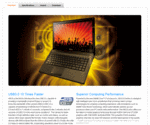
Speakers
The stereo speakers are located underneath the wrist-rest. They emit their sound towards the table top and hands on the laptop impair the sound. Hi-fi fans will find the sound to be an insult for the ears and grab headphones strickenly. The manufacturer heralds "Splendid Super Sonic Multimedia Enjoyment" on its website. Super Sonic stands for acoustic high-performance by Asus. SonicMaster models, such as Asus' N71JV, N53JF (Nvidia 415M) or N73JG (Nvidia 425M), have proven to have a very good sound. But, the N82JQ in front of us definitely doesn't belong to them.
The sound is adequate for office, but not more. The speakers extremely emphasizes the trebles and only captures a part of the midranges. Low pitches are completely neglected. Thus, the sound is very thin and not recommendable for listening to music. The maximum volume is adequate, but not particularly strong. Demanding users will connect an external solution in any event. We test the 3.5mm audio jack with two Yamaha speakers (YST-M20SDP). The volume tethered to the notebook doesn't emit an audible static noise (audio test only, no measurement).
Battery Life
How much battery life is appropriate for a quad core 14 incher? Dell's Studio 1557 (164 minutes, 56 Wh, 15.6 inch) and Toshiba's Qosmio X500-121 (168 minutes, 87 Wh, 18.4 inch) prove that three hours are Utopian with a 45 watt CPU (TDP).
However, that our N82JQ only manages two hours with its 63 Wh battery (4400 mAh) is upsetting (WLAN test, 125 minutes). We reduced the brightness to 100 cd/m2 and selected the energy mode, Battery Saving.
The high idle energy requirement is shown in the idle test: It's as dead as stone after only 195 minutes (3:15 hours). This time is however unrealistic in real-life (lowest brightness, disabled wireless modules, CPU idle). The short battery life only grants enough movie entertainment time for a short movie on the train. DVD playback comes to an end after 1:48 hours (108 minutes).
The short battery runtimes nourish the suspicion of a high power consumption. The mulitmeter confirms this. The N82JQ needs a minimum of 19.1 watts (idle, maximum energy savings). The CPU doesn't downclock when the energy settings are on "High Performance" (wireless modules enabled, maximum brightness) in idle. Thus, the power consumption climbs to a steep 31.2 watts.
In comparison: The Sony Vaio EB3Z1E (15.5 inch, i5-460M, HD 5650) in review at the same time only needs 13.5 watts in idle. The Vaio EB3 doesn't have a graphics card that can be turned on and off. In return, it has a CPU with a TDP of only 35 instead of 45 watts).
If the Core i7-720QM and GT 335M now compute with full power (stress test for both), the effective power increases to 111 watts. Such a high power consumption won't be reached in 3D games, as shown by the assessment during 3DMark06: 77.5 watts. The multimeter shows 80.8 watts in a pure CPU stress test (Prime95, 8 x 1.63 GHz).
The 90 watt adapter is absolutely overburdened in view of the maximum possible consumption. There is a discrepancy of over 30 watts. The 67.5 degree hot adapter proves this during the stress test. The system however neither crashed nor were there any other irregularities during the stress test of several hours (CPU: max. 90 degrees).
| Off / Standby | |
| Idle | |
| Load |
|
Key:
min: | |
Verdict
The Asus N82JQ is a potent 14 incher with a strong Intel Core i7 quad core CPU. The combination of a strong midrange GPU and the Nvidia GeForce GT 335M makes the laptop suitable for gaming. The 3D performance is about on par with an ATI HD 5650.
Multimedia fans won't be disappointed in view of the interfaces, including (1) USB 3.0, HDMI, eSATA, Gigabit LAN and draft-n WLAN. The same users will complain about the contrast and color poor glare type display that doesn't have stable viewing angles (1366x768). At least the WXGA screen has a good and even brightness.
We can only praise the 14 incher in terms of workmanship and haptics. The base unit and lid surface is solid. The rubber coated work surface feels nice and the pattern on the aluminum lid looks elegant. Unfortunately, the key's poor feedback doesn't fit in this high-end concept (including mouse pad).
The battery life of 2:05 hours in WLAN surfing is disappointing. That is due to the 720QM's typically high idle power consumption and low battery capacity: 63 Wh, 4400 mAh. However, you'll have to accept this because there aren't any alternatives with 14 inches - that is, if it has to be an Intel quad core device. The step to 15.6 or 16 inches discloses vast quad core options. See: "The competition". The Asus N82 is available for starting at about 949 euro at various online retailers.




